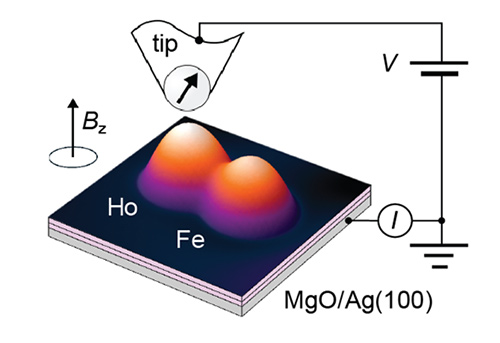
A holmium (Ho) and a iron (Fe) atom placed on a MgO substrate are the components for the world’s smallest memory device. Ho is used as a storage medium and Fe as a sensor were. The magnetism of the holmium atom can be changed or read by flowing current through the STM tip.
Storing 1 bit in 1 atom is possible: The extraordinary end of Moore’s law. One bit of digital information can now be successfully stored in an individual atom, according to a study just published in Nature. Current commercially-available magnetic memory devices require approximately 1 million atoms to do the same. Andreas Heinrich, newly appointed Director of the Center for Quantum Nanoscience, within the Institute of Basic Science (IBS, South Korea), led the research effort that made this discovery at IBM Almaden Research Center (USA). This result is a breakthrough in the miniaturization of storage media and has the potential to serve as a basis for quantum computing.
Disks coated with a magnetized layer of metal allow our computers to store files in the form of bits, each with the value of either 1 or 0. A certain direction of magnetization corresponds to the 0 bit, the other direction to the 1 bit. While at the moment small areas of the disk, of around a million atom, correspond to each digital bit of information, this research went way beyond this and utilized the smallest amount of matter usable for this purpose: one atom.
In this study, they used a Scanning Tunneling Microscope (STM), which has a special tip that enables the user to view and move individual atoms, as well as to apply a pulse of electrical current to them. They used this electric pulse to change the direction of magnetization of individual holmium atoms. By doing that, the team could write a memory of either 1 or 0 in a single holmium atom as well as swap the two.
A quantum sensor was used to read the memory stored in the holmium atom. It consists of an iron atom placed next to the holmium atom. Using this technique, as well as tunnel magnetoresistance, the researchers could observe that holmium maintains the same magnetic state stably over several hours. Then, when Heinrich’s team of researchers tried to use two holmium atoms instead of one, they made another surprising discovery. Placing holmium atoms even 1 nanometer apart did not impact their ability to store information individually. This came as a surprise, since it was expected that the magnetic field from one atom would impact its neighbor.
In this way, the scientists could build a two bit device with 4 possible types of memory: 1-1, 0-0, 1-0 and 0-1 clearly distinguished by the iron sensor. Moore’s Law predicted that the amount of data that can be stored on a microchip would double every 18 months and indeed this happened for decades. The last model electronic devices are always smaller and more powerful than the previous one. However, as devices becomes smaller and smaller, since atoms are so close to each other, new interfering quantum properties begin to cause problems.
Interestingly, holmium atoms seem to escape this fate, for still unknown reasons. “There are no quantum mechanical effects between atoms of holmium. Now we want to know why,” points out Heinrich. Holmium atoms can be arranged very closely together, so the storage density using this single-atom technique could be very high. He continues: “We have opened up new possibilities for quantum nanoscience by controlling individual atoms precisely as we want. This research may spur innovation in commercial storage media that will expand the possibilities of miniaturizing data storage.”
http://www.ibs.re.kr/cop/bbs/BBSMSTR_000000000738/selectBoardArticle.do?nttId=14355







Recent Comments